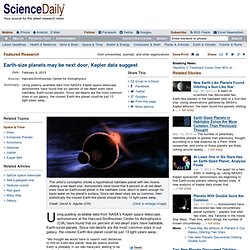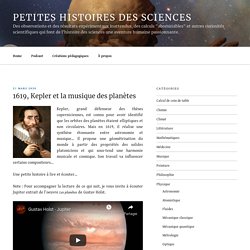

Des observateurs aux explorateurs de l' espace. Revenir à la liste principale Astronomie des mouvements de la terre dans l'espace: 1.

Les premiers observateurs du ciel et des astres 1a. La Sphère Céleste 1b. Trouver l' Etoile Polaire 2. Le rôle central du Soleil 9a. . (1) Le système solaire(2) Mercure(3) Venus(4) La Terre(5) Mars(6) Asteroides(7) Jupiter(8) Io et les autres lunes de Jupiter(9) Saturne(10) Téléscopes(11) Uranus (12) Neptune (13) Pluton et la ceinture de Kuiper (14) Comètes, et autres petit objets ================================= 9c. " Les trois lois de Kepler sur le mouvement planétaire" Revue générale à l'intention des enseignants en Science Texte est issu d'une conférence donnée le 23 mars 2005. 10. Sections facultatives: le passage 2004 de Venus 12c. La mécanique de Newton 13. 16. 19. Optionnel : 21b. 22. Le Soleil Le Soleil--Introduction S-1. S-2. Sections facultatives: Physique Quantique Q-1. Earth-size planets may be next door, Kepler data suggest.
Using publicly available data from NASA's Kepler space telescope, astronomers at the Harvard-Smithsonian Center for Astrophysics (CfA) have found that six percent of red dwarf stars have habitable, Earth-sized planets.

Since red dwarfs are the most common stars in our galaxy, the closest Earth-like planet could be just 13 light-years away. "We thought we would have to search vast distances to find an Earth-like planet. Now we realize another Earth is probably in our own backyard, waiting to be spotted," said Harvard astronomer and lead author Courtney Dressing (CfA). Dressing presented her findings today in a press conference at the Harvard-Smithsonian Center for Astrophysics in Cambridge, Mass. Red dwarf stars are smaller, cooler, and fainter than our Sun. Despite their dimness, these stars are good places to look for Earth-like planets. Dressing culled the Kepler catalog of 158,000 target stars to identify all the red dwarfs. Our Sun is surrounded by a swarm of red dwarf stars.
Cosmos. Spatial Retention of Ions Producing the IBEX Ribbon - Abstract - The Astrophysical Journal. Asteroid 2012 DA14's Friday Flyby: A Skywatcher's Guide. Scientists and amateur observers alike are eagerly awaiting Friday's historic flyby of asteroid 2012 DA14, which will zoom inside Earth's ring of geosynchronous satellites.

At its nearest approach Friday (Feb. 15), the 150-foot-wide (45 meters) asteroid 2012 DA14 will be just 17,200 miles (27,000 kilometers) from Earth — the closest encounter with such a large space rock that researchers have ever known about in advance. You can watch the asteroid 2012 DA14 flyby on SPACE.com today during a series of free webcasts Astronomers will take full advantage of the flyby, tracking the near-Earth asteroid with a variety of instruments to learn more about it and space rocks in general.
And some well-placed skywatchers may be able to follow 2012 DA12 's path across the heavens Friday as well, weather permitting. Will you be able to see it? As in real estate, the key to viewing the flyby is location, location, location. At the time of its closest approach on Friday — 2:24 p.m. How to find it. NASA - Home. S Goddard Space Flight Center. 2013 - 06 - Sterex images of ATV-4 launch.
Sterex images of ATV-4 launch Watch in: Views: 371 Rating: 5.00 /5 ( 12 votes cast) Rate this Video Thank you for rating!

You have already rated this page, you can only rate it once! Your rating has been changed, thanks for rating! Embed Code Details Title Sterex images of ATV-4 launch Released 07/06/2013 Length 00:02:52 Language English Footage Type Documentary Copyright ESA /DLR-BMWi 2013 Description ESA's ATV-4 launch images taken by the Sterex experiment. Astronomie en Egypte ancienne. 1619, Kepler et la musique des planètes – Petites histoires des sciences. Kepler, grand défenseur des thèses coperniciennes, est connu pour avoir identifié que les orbites des planètes étaient elliptiques et non circulaires.

Mais en 1619, il réalise une synthèse étonnante entre astronomie et musique… Il propose une géométrisation du monde à partir des propriétés des solides platoniciens et qui sous-tend une harmonie musicale et cosmique. Son travail va influencer certains compositeurs… Une petite histoire à lire et écouter… Note : Pour accompagner la lecture de ce qui suit, je vous invite à écouter Jupiter extrait de l’oeuvre Les planètes de Gustav Holst. L’Univers de Kepler Dès son enfance, Johannes Kepler acquiert une éducation à la fois musicale et mathématique à l’université de Tübingen qu’il fréquence de 1589 à 1594.
Par cette structure, les distances des planètes au Soleil (dans le modèle copernicien) sont approximativement correctes. L’Harmonie du monde Il réalise la correspondance complète entre données astronomiques et théorie musicale pour conclure :